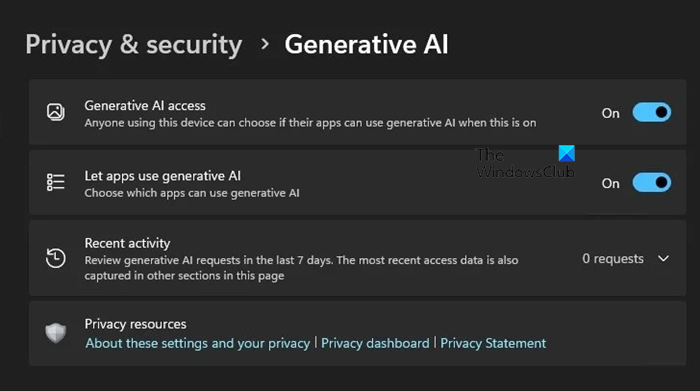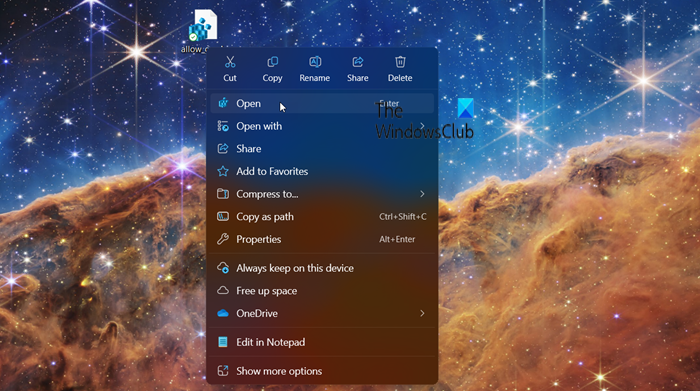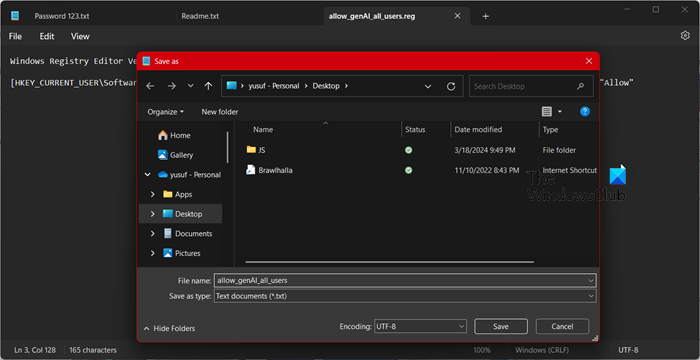Microsoft has added a Generative AI section to Settings > Privacy & security of Windows 11 to control apps’ access to artificial intelligence. In this post, we will discuss how to enable or disable apps access to Generative AI in Windows 11.
How to enable or disable apps access to Generative AI in Windows 11?
To enable or disable app access to the Generative AI in Windows 11, use one of the following methods.
- Turn on or off apps access to Generative AI from Settings
- Turn on or off apps access to Generative AI from Group Policy Editor
- Turn on or off apps access to Generative AI from the Registry Editor
Let us discuss them in detail.
1] Turn on or off apps access to Generative AI from Settings

First of all, let us talk the easy route and configure Generative AI using the Settings app that is preinstalled on your computer. You can follow the steps mentioned below.
- Open Settings.
- Navigate to Privacy & security > Generative AI.
- Now, turn off the toggle for Generative AI access and Let apps use generative AI to forbid apps from using generative AI.
You can also configure which app should use Generative AI from there. To enable the settings, you just have to switch on the toggles.
Read: How to Turn off AI in Edge browser
2] Turn on or off apps access to Generative AI from the Group Policy Editor
The Group Policy Editor allows you to configure your system’s policy to change its behavior. One needs to be an administrator to access and configure the Group Policy Editor and the changes made will be applied to all the users connected to the system. In order to configure apps access to Generative AI, follow the steps mentioned below.
- Launch Run by Win + R, type “gpedit.msc”, and hit Enter.
- Navigate to – Computer Configuration > Administrative Templates > Windows Components > App Privacy.
- Look for Let Windows apps make use of generative AI features of Windows and then configure it.
- To enable generative AI for all users – Select Enabled, set Default for all apps to Force allow, and click on Apply > Ok.
- To disable generative AI for all users – Select Disabled, set Default for all apps to Force deny, and click Apply > Ok.
Hopefully, this will do the job for you.
3] Turn on or off apps access to Generative AI using the Registry Editor

Registry Editor is a hierarchical database of registries that are preinstalled on your computer. If you are not using Windows 11 Pro or Enterprise, you will not have a Group Policy Editor on your computer; however, you can use Registry Editor to do the same.

In order to do that, we are going to create a registry script that we can run. But before making any changes to the registries, it is always recommended to take a backup of your existing Registry Editor. To do the same, open Registry Editor, click on File > Export, and save the file to a location of your choice.

After taking a backup of your Registry Editor, open Notepad, and paste one of the following codes.
Allow apps to access Generative for the current user
Windows Registry Editor Version 5.00
[HKEY_CURRENT_USER\Software\Microsoft\Windows\CurrentVersion\CapabilityAccessManager\ConsentStore\generativeAI] "Value"="Allow"
Allow apps to access Generative for the current user
Windows Registry Editor Version 5.00
[HKEY_CURRENT_USER\Software\Microsoft\Windows\CurrentVersion\CapabilityAccessManager\ConsentStore\generativeAI] "Value"="Deny"
Allow apps to access Generative for all users
Windows Registry Editor Version 5.00 [HKEY_LOCAL_MACHINE\SOFTWARE\Microsoft\Windows\CurrentVersion\CapabilityAccessManager\ConsentStore\generativeAI] "Value"="Allow"
Do not allow apps to access Generative for all users
Windows Registry Editor Version 5.00 [HKEY_LOCAL_MACHINE\SOFTWARE\Microsoft\Windows\CurrentVersion\CapabilityAccessManager\ConsentStore\generativeAI] "Value"="Deny"
Always Enable Apps Access to Generative AI for all users
Windows Registry Editor Version 5.00 [HKEY_LOCAL_MACHINE\SOFTWARE\Policies\Microsoft\Windows\AppPrivacy] "LetAppsAccessGenerativeAI"=dword:00000001 "LetAppsAccessGenerativeAI_UserInControlOfTheseApps"=hex(7):00,00 "LetAppsAccessGenerativeAI_ForceAllowTheseApps"=hex(7):00,00 "LetAppsAccessGenerativeAI_ForceDenyTheseApps"=hex(7):00,00
Disable Apps Access to Generative AI for all users
Windows Registry Editor Version 5.00 [HKEY_LOCAL_MACHINE\SOFTWARE\Policies\Microsoft\Windows\AppPrivacy] "LetAppsAccessGenerativeAI"=dword:00000002 "LetAppsAccessGenerativeAI_UserInControlOfTheseApps"=hex(7):00,00 "LetAppsAccessGenerativeAI_ForceAllowTheseApps"=hex(7):00,00 "LetAppsAccessGenerativeAI_ForceDenyTheseApps"=hex(7):00,00
Set default User-choice Apps Access to Generative AI
Windows Registry Editor Version 5.00 [HKEY_LOCAL_MACHINE\SOFTWARE\Policies\Microsoft\Windows\AppPrivacy] "LetAppsAccessGenerativeAI"=- "LetAppsAccessGenerativeAI_UserInControlOfTheseApps"=- "LetAppsAccessGenerativeAI_ForceAllowTheseApps"=- "LetAppsAccessGenerativeAI_ForceDenyTheseApps"=-
You can save the file with any name of your choice but keep the extension .reg. This will allow it to make changes to your existing registries. Make sure not to save all the scripts in a single file; instead, make separate files with separate names. To run, all you have to do is run the file that you have created and you will be good to go.
Hopefully, now you can configure the app’s access to Gen AI on your Windows computer.
Read: Enable or disable Scroll to open Copilot feature in Bing Search
How do I restrict access to apps in Windows 11?
To restrict app access or change permissions in Windows 11, open Settings and go to Privacy & security. Then, go to Apps permission and click on the option you need to configure. Then, turn on or off the toggle for the apps you need to grant or revoke permissions from.
Read: Copilot Image Generator Alternatives
How to disable CoPilot Windows 11 GPO?
To disable CoPilot GPO on Windows 11, open Group Policy Editor, and then navigate to User Configuration > Administrative Templates > Windows Components > Windows CoPilot. Look for Turn off Windows CoPilot and then set it to Enabled.
Also Read: Remove Copilot from Taskbar in Windows 11.